
Recently NOAA Teacher at Sea Jason Moeller was interviewed about his cruise.
Read this article in the knoxnews.com about Jason.
Read this interview in the metropulse.com about Jason.
Read this article in the Stanford Daily about Jason.

Recently NOAA Teacher at Sea Jason Moeller was interviewed about his cruise.
Read this article in the knoxnews.com about Jason.
Read this interview in the metropulse.com about Jason.
Read this article in the Stanford Daily about Jason.
NOAA TEACHER AT SEA
JASON MOELLER
ONBOARD OSCAR DYSON
JUNE 11-JUNE 30
NOAA Teacher at Sea: Jason Moeller
Ship: Oscar Dyson
Mission: Walleye Pollock Survey
Geographic Location: Kodiak Harbor
Date: June 29-30
Ship Data
Latitude: 57.78 N
Longitude: -152.42 W
Wind: 4.9 knots
Surface Water Temperature: 8.5 degrees C
Air Temperature: 9.1 degrees C
Relative Humidity: 69%
Depth: 18.99
Personal Log
For the last time, welcome aboard!
We are now back in Kodiak, and I fly out on Thursday, June 30th. We got in late on the 28th, and so that gave us some time to explore! Once again, it was back to the trail to try and look for some bears!


On June 29th, after stopping for some Mexican food, Paul, Jake, Jodi and I hopped in a car and drove out to Anton Larsen Bay in hopes of some great photo opportunities and wildlife. Below are some of the best photographs that I took of the trip.









Science and Technology Log
As the survey is now over, there is no science and technology log.
Species Seen
Gulls
Arctic Tern
Bald Eagle
Red Fox
Mouse
Reader Question(s) of the Day!
There are no questions of the day for this last log. However, I would like to extend some thank yous!
First, I would like to thank the NOAA organization for allowing me the wonderful opportunity to travel aboard the Oscar Dyson for the past three weeks. I learned an incredible amount, and will be able to bring that back to my students. I had a great time!
Second, I would like to thank the crew of the ship for letting me come onboard and participate in the survey. Thanks for answering all of my questions, no matter how naive and silly, teaching me about how research aboard this vessel really works, editing these blogs, and for giving me the experience of a lifetime.
Third, I would like to thank Tammy, the other NOAA Teacher at Sea, for all of the help and effort that she put into working with me on the science and technology section of the blog. Tammy, I could not have done it without you!
Next, a huge thank you to the staff of Knoxville Zoo for their support of the trip and granting me the time off! A special thanks especially needs to go to Tina Rolen, who helped edit the blogs and worked with the media while I was at sea. She helped keep me from making a complete fool of myself to the press. Another special thanks goes out to Dr. John, who loaned me the computer that I used to post the first several logs.
Thanks also go out to Olivia, my wonderful and beautiful wife, for supplying the camera that I used for the first half of the trip.
Finally, I would like to thank everyone who read the log and sent comments! I received many positive comments on the photography in this blog, although I must confess that I laughed a bit at those. Paul, our chief scientist, is the expert photographer on board, and his photos expose me for the amateur that I actually am. I would like to end this blog by posting some of the incredible images he gave me at the end of the trip.





NOAA TEACHER AT SEA
JASON MOELLER
ONBOARD NOAA SHIP OSCAR DYSON
JUNE 11 – JUNE 30, 2011
NOAA Teacher at Sea: Jason Moeller
Ship: Oscar Dyson
Mission: Walleye Pollock Survey
Geographic Location: Whale Pass
Date: June 28-29, 2011
Ship Data
Latitude: 58.01 N
Longitude: -152.50 W
Wind: 23.95 knots
Surface Water Temperature: 9.4 degrees C
Air Temperature: 10.8 degrees C
Relative Humidity: 71%
Depth: 177.72 m
Personal Log
Welcome back, explorers!
Due to the injury to the deck hand, we are done fishing. Our trip has been cut a day short and we are now headed back to Kodiak. We should arrive tomorrow morning, and I will fly back home on the 30th.
The shortest route to Kodiak was through Whale Pass, a break in Kodiak Island. The pass made for some spectacular scenery.

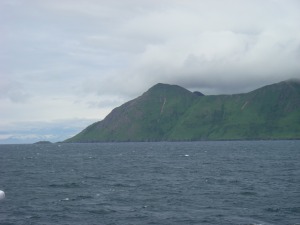
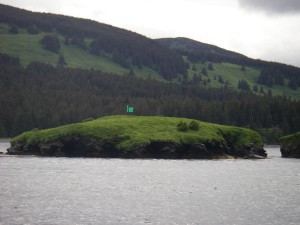


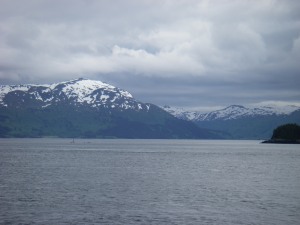

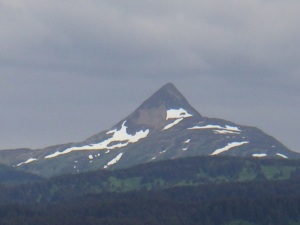
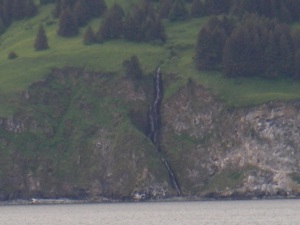
The coolest part of the pass, though, is definitely the wildlife. We saw sea otters everywhere! Unfortunately, they were so fast and at a great enough distance that the following shot is the only decent one I was able to take.

We also saw an animal that I have been hoping to see for a long time.

We also saw a puffin, but it moved so quickly that there was no hope at a photo for it. Bummer. Several humpback whales were also spotted, along with numerous gulls and other seabirds.
Science and Technology Log
Today, lets talk about krill!
What are krill, you ask? They’re animals in the Phylum Arthropoda, which means they’re related to insects, spiders, crabs, lobsters, etc. They have jointed legs and an exoskeleton, are usually a couple of centimeters in length, and are reddish/orange-ish in color. They can often be found in dense schools near the surface of the water, and play an important role in the ecosystem as a source of food for lots of larger animals (like fish, whales, & penguins).
I’ve mentioned the two types of trawl gear that we use to catch fish, but if we want to catch smaller things like plankton, the mesh on those nets is way too small. Therefore, we use a third type of trawl called the Methot which has very fine mesh to corral the plankton down into a collection container at the end of the net. In addition to having a hard container at the end — as opposed to just a bag/codend that you see in the fish trawls — the Methot trawl also has a large metal frame at the beginning of the net. Check out the photos below.


After the net is brought back on deck, one of the fishermen or deck hands brings the container of krill into the fish lab. The first thing we do is dump the container into a sieve or a bucket and start picking out everything that isn’t krill. The two most common things that are collected (besides krill) are gelatinous animals (like jellyfish & salps) and larval fish. The fish get weighed (as one big unit, not individually) and then frozen for someone to look at later on.

After sorting the catch, we’re left with a big pile of krill, which gets weighed. We then take a small subsample from the big pile of krill (it’s a totally random amount depending on how much we scoop out!) and then weigh the subsample. Then the fun begins, as I’m the one that does this job; I get to count every single individual krill in the subsample. Tedious work. All of the data is then entered into the computer system, and the krill and anything else that we’ve caught (besides the larval fish) are thrown back into the water.
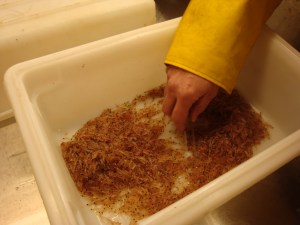

Species Seen
Northern Fulmar
Gulls
Puffin
Humpback Whales
Killer Whale!!!
Sea Otters!!!
Reader Question(s) of the Day!
Q. What has been your favorite thing about this trip so far?
A. I’ve been asked this question several times over the course of the last few weeks, but I’ve waited until the end to answer it.
Truth be told, it’s almost impossible to pick a favorite thing that I’ve seen or done. There are so many candidates! Exploring the Buskin River and seeing bald eagles before we set sail was a blast! Eating fresh caught salmon for the first time was a great experience, as it just melted in my mouth. Leaving shore for the first time was a lot of fun, as there is no feeling like the salt air blowing past your face at the front of a boat. Trying to take pictures of flying birds with a digital camera was a challenge, and we all had a good time laughing at the blurred images. Getting better at photography is something I’ve always wanted to do, and I feel like I have improved that. The first fish lab with the sleeper shark was great! Working in the fish lab, as messy as it was, was also a lot of fun! The XBT prank that was pulled on me was one of the best executed pranks I’ve ever seen, and it was hilarious! Hanging out and reading Martin’s Game of Throne series during breaks with my fellow scientists was a lot of fun as well, as it was just like a book club. Today’s ride through Whale Pass with the otters, whales, and mountains was exactly what I dreamed Alaska would be like.
The scientists sense of humor also made it an enjoyable trip. For example, this is what happens when you play around with the net camera for too long.

That being said, if I was absolutely forced to pick a favorite memory, it would probably the impromptu fishing trip at Sand Point. You know you love your job when you decide to keep going at it on your day off.
There will be one last log posted, so if you have questions please send them to me at jmoeller@knoxville-zoo.org!
NOAA TEACHER AT SEA
JASON MOELLER
ONBOARD NOAA SHIP OSCAR DYSON
JUNE 11 – JUNE 30, 2011
NOAA Teacher at Sea: Jason Moeller
Ship: Oscar Dyson
Mission: Walleye Pollock Survey
Geographic Location: Gulf of Alaska
Dates: June 25-27, 2011
Ship Data
Latitude: 55.58 N
Longitude: -159.16 W
Wind: 14.11
Surface Water Temperature: 7.2 degrees C
Air Temperature: 9.0 degrees C
Relative Humidity: 90%
Depth: 85.61
Personal Log
Anyone who has seen the show Deadliest Catchknows how dangerous crab fishing can be. Fishing for pollock, however, also has its dangers. Unfortunately, we found out the hard way. One of our deck hands caught his hand between a cable and the roller used to pull up the trawl net and hurt himself badly.

Fortunately, the injuries are not life threatening and he will be fine. The injuries did require a hospital visit, and so we stopped at Sand Point to treat him.


We stayed at Sand Point for nearly 48 hours. What did we do? We fished, of course! We used long lines and hooks, and had a great time!






A one-day fishing license in Alaska costs $20.00. We had internet, so five of us went online and bought the fishing passes. Was it worth it?

We filleted it and had the cooks make it for dinner. With the halibut, we also cut out the fleshy “cheeks” and ate them as sushi right on the spot! It doesn’t get any fresher (or tastier!) than that!
Science and Technology Log
Today we will look at the acoustic system of the Oscar Dyson! Acoustics is the science that studies how waves (including vibrations & sound waves) move through solids, liquids, and gases. The Oscar Dyson uses its acoustic system to find the pollock that we process.
The process begins when a piece of equipment called a transducer converts an electrical pulse into a sound wave. The transducers are located on the underside of the ship (in the water). The sound travels away from the vessel at roughly 1500 feet per minute, and continues to do so until the sound wave hits another object such as a bubble, plankton, a fish, or the bottom. When the sound wave hits an object, it reflects the sound wave, sending the sound wave back to the Oscar Dyson as an echo. Equipment onboard listens to the echo.
The computers look at two critical pieces of information from the returning sound wave. First, it measures the time that it took the echo to travel back to the ship. This piece of information gives the scientists onboard the distance the sound wave traveled. Remember that sound travels at roughly 1500 feet per minute. If the sound came back in one minute, then the object that the sound wave hit is 750 feet away (the sound traveled 750 feet to the object, hit the object, and then traveled 750 feet back to the boat).
The second critical piece of information is the intensity of the echo. The intensity of the echo tells the scientists how small or how large an object is, and this gives us an idea of what the sound wave hit. Tiny echos near the surface are almost certainly plankton, but larger objects in the midwater might be a school of fish.



One of the things that surprised me the most was that fish and bubbles often look similar enough under water that it can fool the acoustics team into thinking that the bubbles are actually fish. This is because many species of fish have gas pockets inside of them, and so the readout looks very similar. The gas pockets are technically called “swim bladders” and they are used to help the fish control buoyancy in the water.

Species Seen
Northern Fulmar
Gulls
Cod
Pacific Halibut
Flounder
Sea Urchin
Crab
Kelp
Reader Question(s) of the Day
Today’s questions come from Kevin Hils, the Director of Chehaw Wild Animal Park in Chehaw, Georgia!
Q. Where does the ship name come from?
A. Oscar Dyson was an Alaska fisheries industry leader from Kodiak, Alaska. He is best known for pioneering research and development of Alaska’s groundfish, shrimp, and crab industry. Dyson was a founding partner of All Alaskan Seafoods, which was the first company actually controlled by the fishermen who owned the vessel. He also served on the North Pacific Fisheries Management council for nine years. He is in the United Fishermen of Alaska’s hall of fame for his work. The ship was christened by his wife, Mrs. Peggy Dyson-Malson, and launched on October 17, 2003.

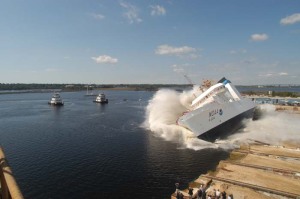
Q. How do you see this helping you teach at Knoxville Zoo, not an aquarium?
A. This will be a long answer. This experience will improve environmental education at the zoo in a variety of different ways.
First, this will better allow me to teach the Oceanography portion of my homeschool class that comes to the zoo every Tuesday. For example, I am in the process of creating a hands on fishing trip that will teach students about the research I have done aboard the Oscar Dyson and why that research is important. Homeschool students will not just benefit from this experience in Oceanography, but also in physics (when we look at sound and sonar) and other subjects as well from the technical aspects that I have learned during the course of the trip.
Scouts are another group that will greatly benefit from this experience as well. The Girl Scout council wishes to see a greater emphasis in the future on having the girls do science and getting real world experiences. While the girls are still going to desire the animal knowledge that the zoo can bring, they will also expect to do the science as well as learn about it. My experience aboard the Dyson will allow me to create workshops that can mimic a real world animal research experience, as I can now explain and show how research is done in the field.
The same can be said of the boy scouts.
In addition, one of the most common badges that is taught to boy scout groups that come in is the fish and wildlife merit badge. In the past, the badge has primarily focused on the wildlife aspect of this topic. However, I now have the knowledge to write and teach a fisheries portion for that merit badge, as opposed to quickly covering it and moving on. This will enrich future scouts who visit the zoo for this program.
A major focus for all scouts is the concept of Leave No Trace, where scouts are supposed to leave an area the way they found it. The fisheries research being done aboard the Dyson is focused toward that same goal in the ocean, where we are attempting to keep the pollock population as we found it, creating a sustainable fishery. The goal aboard the Dyson is similar to the goal in scouting. We need to be sustainable, we need to be environmentally friendly, and we need to leave no trace behind.
School children on field trips will greatly benefit, especially students in the adaptations section. There are some bizarre adaptations that I never knew about! For example, sleeper sharks slow, deliberate movement coupled with their fin and body shape basically make them the stealth fighter of the fish world. They can catch fish twice as fast as they are! Lumpsuckers are neat critters too! This knowledge will enhance their experience at the zoo during field trip programs.
Finally, I can pass the knowledge from this experience on to my coworkers. This will not only better the experience of my students, but it will also improve the outreach programs, the bedtime programs, the camps, and other programming done at the zoo.
Q. Are you old enough to be on a ship? You look like you’re 13???!!!!
A. SHHHHHHH!!!! You weren’t supposed to tell them my real age! They think I’m 24!
NOAA TEACHER AT SEA
JASON MOELLER
ONBOARD NOAA SHIP OSCAR DYSON
JUNE 11-JUNE 30, 2011
NOAA Teacher at Sea: Jason Moeller
Ship: Oscar Dyson
Mission: Walleye Pollock Survey
Geographic Location: Gulf of Alaska
Date: June 23-24, 2011
Ship Data
Latitude: 54.86 N
Longitude: -161.68 W
Wind: 12.1 knots
Surface Water Temperature: 8.5 degrees C
Air Temperature: 9.1 degrees C
Relative Humidity: 95%
Depth: 52.43 m
Personal Log
As I mentioned in the last post, everything here has settled into a routine from a personal standpoint, and on that end there is not much to write about. However, there were three things that broke up the monotony. First, as always, the scenery was beautiful.
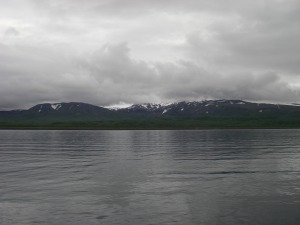

Second, I found out that even with all of the modern equipment on board, catching fish is still not guaranteed. We trawled three times last night on the 23rd and caught a total of 14 fish in all three trawls! Remember, a good sample size for one trawl is supposed to be 300 pollock, so this is the equivalent of fishing all day long and catching a minnow that just happened to swim into the fishing hook.
The first trawl caught absolutely nothing, as the fish dove underneath the net to escape the danger. The second trawl caught two pacific ocean perch and one pollock, and the third trawl caught eleven pollock. All in all, not the best fishing day.

Despite the poor fishing, we did bring up this neat little critter.
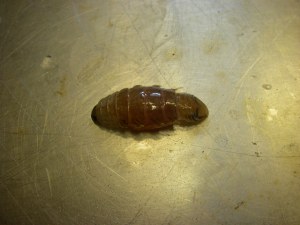

The third thing to break up the monotony was the Aleutian Islands earthquake. On the evening of June 23rd, a magnitude 7.2 earthquake shook the Aleutian Islands. According to ABC news, the earthquake was centered about 1,200 miles southwest of Anchorage. The quake spawned a brief tsunami warning that caused a large number of Dutch Harbor residents (Dutch Harbor is the home base of the show Deadliest Catch) to head for higher ground. We had been in the Aleutian Islands and Dutch Harbor area on our survey route, but had left two days before, so the Oscar Dysonwas completely unaffected by the earthquake.

Science and Technology Log
In order to obtain photos of all of this neat sealife, we first have to catch it! We catch fish by trawling for them. Some of you may not know exactly what I’m talking about, so let me explain. Trawling is a fishing method that pulls a long mesh net behind a boat in order to collect fish. Trawling is used to collect fish for both scientific purposes (like we’re doing) and also in commercial fishing operations. We have two types of fish trawls onboard the NOAA Ship Oscar Dyson — a mid-water trawl net and a bottom trawl net. We’ve used both types throughout our cruise, so let me tell you a little about each.
The mid-water trawl net is just as it sounds — it collects fish from the middle of the water column — not those that live on the seafloor, not those that live at the surface. The technical name for the net we have is an Aleutian Wing Trawl (AWT) — it’s commonly used by the commercial fishing industry.
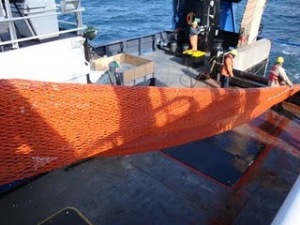
The end of the net where the fish first enter has very large mesh, which is used to corral the fish and push them towards the bag at the end. The mesh gets progressively smaller and smaller the further into it you go, and at the very end (where the collecting bag is), the mesh size is 0.5 inches. The end (where the bag is, or where the fish are actually collected) is called the codend.

This is the kind of net we use when we want to collect a pollock sample, because pollock are found in the water column, as opposed to right on the seafloor (in other words, pollock aren’t benthic animals). Our particular net is also modified a little from a “normal” AWT. Our trawl has three codends (collecting bags) on it, each of which can be opened and closed with a switch that is controlled onboard the ship. The mechanism that opens and closes each of the 3 codends is called the Multiple Opening and Closing Codend (MOCC) device. Using the MOCC gives us the ability to obtain 3 discrete samples of fish, which can then be processed in the fish lab.



One other modification we have on our mid-water trawl net is the attachment of a video camera to the net, so we can actually see the fish that are going into the codends.

When we spot a school of fish on the acoustic displays, we then radio the bridge (where the captain is) and the deck (where the fishermen are) to let them know that we’d like to fish in a certain spot. The fishermen that are in charge of deploying the net can mechanically control how deep the net goes using hydraulic gears, and the depth that we fish at varies at each sampling location. Once the gear is deployed, it stays in the water for an amount of time determined by the amount of fish in the area, and then the fishermen begin to reel in the net. See the videos below to get an idea of how long the trawl nets are — they’re being reeled in the videos. Once all of the net (it’s VERY long — over 500 ft) is reeled back in, the fish in the codends are unloaded onto a big table on the deck using a crane. From there, the fish move into the lab and we begin processing them.
Videos of the net being reeled in and additional photos are below!
http://www.youtube.com/watch?v=I50Q4SJzzaE
http://www.youtube.com/watch?v=VVAqbAGcxRs




The other type of trawl gear that we use is a bottom trawl, and again, it’s just as it sounds. The bottom trawl is outfitted with roller-type wheels that sort of roll and/or bounce over the seafloor. We use this trawl to collect benthic organisms like rockfish, Pacific ocean perch, and invertebrates. There’s usually a random pollock or cod in there, too. The biggest problem with bottom trawls is that the net can sometimes get snagged on rocks on the bottom, resulting in a hole being ripped in the net. Obviously, we try to avoid bottom trawling in rocky areas, but we can never be 100% sure that there aren’t any rogue rocks sitting on the bottom 🙂

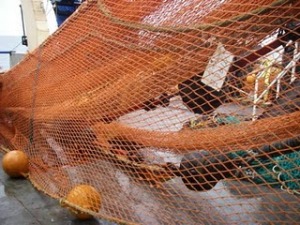
Species Seen
Northern Fulmar
Gulls
Pollock
Pacific Ocean Perch (aka rockfish)
coral
Isopod
Reader Question(s) of the Day!
The first question for today comes from Rich, Wanda, and Ryan Ellis! Ryan is in the homeschool Tuesday class at the Zoo.
Q. We looked up what an anemone was and we found it was some kind of plant. Is that correct?
A. Great question! The answer is both yes and no. There is a type of flowering plant called the anemone. There are about 120 different species, and they are in the buttercup family. For one example of the plant, look below!
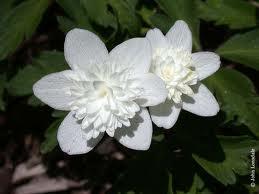
The sea anemone, however, is not actually a plant but an animal! Anemones are classified as cnidarians, which are animals that have specialized cells for capturing prey! In anemones, these are called nematocysts, which have toxin and a harpoon like structure to deliver the toxin. When the nematocysts are touched, the harpoon structure injects the toxin into the animal that touches it.
Cnidarians also have bodies consist of mesoglea, a non living jelly like substance. They generally have a mouth that is surrounded by the tentacles mentioned above.

The second question comes from my wife Olivia.
Q. What has surprised you most about this trip? Any unexpected or odd situations?
A. I think the thing that has surprised me the most is the amount of down time I have had. When I came on, I assumed that it would be physical and intense, like the show Deadliest Catch, where I would spend my whole time fishing and then working on the science. I figured that I would be absolutely toast by the end of my shift.
While I have worked hard and learned a lot, I have quite a bit of down time. Processing a catch takes about one hour, and we fish on average once or twice a night. That means I am processing fish for roughly two hours at most, and my shift is twelve hours. I have gotten a fair amount of extra work done, as well as a lot of pleasure reading and movie watching.
As for unexpected and odd situations, I didn’t really expect to get your camera killed by a wave. Fortunately, I have been allowed to use the scientist camera, and have been able to scavenge photos from other cameras, so I will still have plenty of pictures.
Another technological oddball that I didn’t think about beforehand was that certain headings (mainly if we are going north) will cut off the internet, which is normally fantastic. It is frustrating to have a photo 90% downloaded only to have the ship change vectors, head north, and cut off the download, forcing me to redownload the whole photo.
I also didn’t expect that the fish would be able to dodge the trawl net as effectively as they have. We have had four or five “misses” so far because the fish will not stay in one spot and let us catch them. While the use of sonar and acoustics has greatly improved our ability to catch fish, catching fish is by no means assured.
Perhaps the biggest “Are you kidding me?” moment though, comes from James and David Segrest asking me about sharks (June 17-18 post). An hour after I read the question, we trawled for the first time of the trip, and naturally the first thing we caught was the sleeper shark. Also naturally, I haven’t seen a shark since. Sometimes, you just get lucky.
NOAA TEACHER AT SEA
JASON MOELLER
ONBOARD NOAA SHIP OSCAR DYSON
JUNE 11 – JUNE 30, 2011
NOAA Teacher at Sea: Jason Moeller
Ship: Oscar Dyson
Mission: Walleye Pollock Survey
Geographic Location: Gulf of Alaska
Dates: June 21-22, 2011
Ship Data
Latitude: 55.03N
Longitude: -163.08W
Wind: 17.81 knots
Surface Water Temperature: 6.7 degrees celsius
Air Temperature: 10.10 degrees celsius
Humidity: 85%
Depth: 82.03 meters
Personal Log
Welcome back, explorers!
June 21
Today has been the calmest evening since I boarded the Oscar Dyson. The night shift did not fish at all, which meant that I basically had an evening off! Even the evenings we have fished have been relatively calm. It takes us about an hour to an hour and a half to process a haul of fish, and up to this point we average about one haul per night. That gives me quite a bit of down time! When I am on shift, that down time is usually spent in one of two places.


When I am not sitting in one of these two places, I am usually running around the ship with my camera taking nature photos. Below are the best nature photos of the past three days.



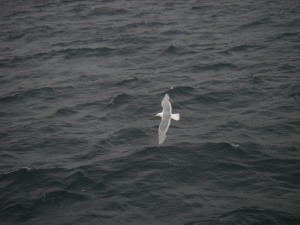
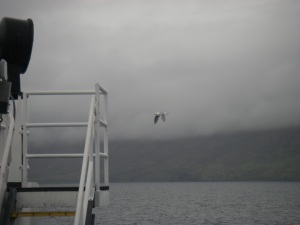
June 22
We resumed fishing today! These trawls brought in quite a few species that I had not seen before, along with the ever plentiful pollock.
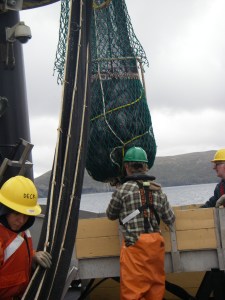








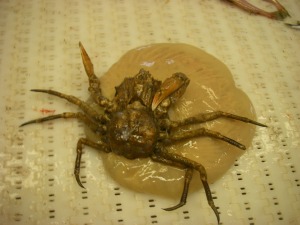

Science and Technology Log
There is no Science and Technology Log with this post.
Species Seen
Humpback Whales
Northern Fulmar
Gulls
Rockfish
Walleye Pollock
Lumpsucker
Arrowtooth Flounder
Atka Makerel
Salmon
Sculpin
Copepods
Isopods
Skate
Crab!!!
Reader Question(s) of the Day!
Today’s question comes from James and David Segrest, who are two of my homeschool students!
Q. What do you eat while you are on your adventures? Do you get to catch and eat fish?
The food is great! Our chef has a degree in culinary arts, and has made some amazing meals!
I wake up at 2:30 pm for my 4 pm to 4 am night shift, and usually start my day with a small bowl of oatmeal and a toasted bagel. At 5 pm, about two hours after breakfast, dinner is served, and I will eat a huge meal then too. Every meal has two main courses, a vegetable, a bread, and dessert. We have had a wide variety of main courses which have included bratwurst, steak, gumbo with king crab, fish, chicken parmesan, spaghetti with meatballs, and others!
We will often eat some of the fish we catch, usually salmon and rockfish since those provide the best eating. The salmon disappears to the kitchen so quickly that I have not actually been able to get a photo of one! We have not caught a halibut in the trawl net yet, otherwise we would likely have eaten that as well. Yum! We have not yet eaten pollock, as it is viewed as being a much lower quality fish compared with the rockfish and salmon.
I’m out of questions, so please email me at jmoeller@knoxville-zoo.org with those questions please!
NOAA TEACHER AT SEA
JASON MOELLER
ONBOARD NOAA SHIP OSCAR DYSON
JUNE 11 – JUNE 30, 2011
NOAA Teacher at Sea: Jason Moeller
Ship: Oscar Dyson
Mission: Walleye Pollock Survey
Geographic Location: Gulf of Alaska
Dates: June 19-20, 2011
Ship Data
Latitude: 54.29 N
Longitude: -165.13 W
Wind: 12.31 knots
Surface Water Temperature: 5.5 degrees Celsius
Air Temperature: 6.1 degrees Celsius
Humidity: 97%
Depth: 140.99 meters
Personal Log
Welcome aboard, explorers!
To be honest, there is not a great deal to write about for the personal log. My daily schedule has settled in quite nicely! I get off work at 4 in the morning, shower, sleep until 2:30 in the afternoon, and then head down to the acoustics room where we track the fish. When we are processing a catch (see the science and technology section of this blog), I am in the fish lab wearing bright orange waterproof clothes that make me resemble a traffic cone.

The rest of the time is down time, which is spent reading, working on the blog, learning about the ship, and dreaming up lesson plans that I can use to torment my students. I hope they are interested in a summer fishing trip, as that is the one I am currently planning.
Most of the blog work involves running around and taking photographs. My wife’s camera was soaked beyond repair during the prank that was pulled (see the previous post) as Sarah was holding the camera when the wave came over the railing. Fortunately, there was another camera on board.
Our survey is keeping us very close to the coast and islands of Alaska. As a result, I’ve gotten some gorgeous photos. This place is just beautiful.





Science and Technology Log

We finally started fishing! As I mentioned in my very first blog, the Oscar Dyson is surveying walleye pollock, which is an important fish species here in Alaska. Walleye pollock make up 56.3% of the groundfish catch in Alaska, and is eaten in fast food restaurants around the world such as Wendy’s, McDonalds, and Burger King. It is also used to make imitation crabmeat.
Our first catch had a little over 300 walleye pollock, and we processed all of them. Three hundred is an ideal sample size for this species. If, for example, we had caught 2,000 pollock, we would only have processed 300 of the fish, and we would have released the rest of them back into the ocean.
The photo captions below will provide a tour of the fish lab as well as introduce blog readers to the data we wish to collect and how scientists aboard the Oscar Dyson collect it.
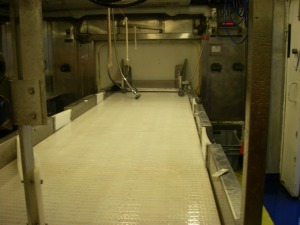



From this catch (we will do this for any following catch as well) we also took and preserved twenty stomachs from random fish. This was done in order to later analyze what the pollock had eaten before they died. We also took forty otoliths from random pollock as well. An otolith is the ear bone of the pollock, and it is incredibly important to researchers as they will tell the pollock’s age in a similar manner to the way a tree’s rings will.


While looking at pollock is the main focus of the survey, we did run into some other neat critters in this haul as well!





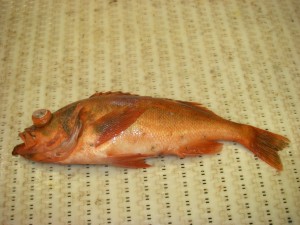
Species Seen
Albatross
Northern Fulmar
Gulls
Rockfish
Walleye Pollock
Lumpsucker
Arrowtooth Flounder
Atka Mackerel
Salmon
Pacific Grenadier
Squid
Shrimp
Basket Starfish
Reader Question(s) of the Day!
Today’s question is actually a request. It comes from Tish Neilson, one of our homeschool parents.
Hey Jason –
I had a super favor to ask of you. There is a little girl from Jackson’s school that is a 5th grader and she was recently diagnosed with leukemia. There have been some bracelets created for her that say “Going Bananas for Anna” to show support and several moms and I have gotten together and are putting together a scrapbook for her and trying to get as many people as possible wearing her bracelets in really cool places. Then we are having them take pictures to send to us to put in her scrapbook so she can she how far her bracelets have traveled and how many people are pulling for her. If it’s possible to do so and you would be willing to do it I would LOVE to try and get you a bracelet to take some pictures and send to me from Alaska. Her nickname is Anna Banana and she is always asking for pictures and such so that is why we came up with this idea.
Tish Neilson
Unfortunately, I had left for Alaska before I received the email, and as a result I do not have a bracelet. Hopefully, a sign will work just as well.

NOAA TEACHER AT SEA
JASON MOELLER
ONBOARD NOAA SHIP OSCAR DYSON
JUNE 11 – JUNE 30, 2011
NOAA Teacher at Sea: Jason Moeller
Ship: Oscar Dyson
Mission: Walleye Pollock Survey
Geographic Location: Gulf of Alaska
Dates: June 17-18, 2011
Ship Data
Latitude: 52.34 N
Longitude: -167.51 W
Wind Speed: 7.25 knots
Surface Water Temperature: 6.6 Degrees C
Air Temperature: 7.1 Degrees C
Relative Humidity: 101%
Depth: 63.53 meters
All of the above information was found on http://shiptracker.noaa.gov. Readers can use this site to track exactly where I am at all times!
Personal Log
Welcome back, explorers!
It has been a very eventful 24 hours! We have started fishing, but have done so little that I will wait to talk about that in the next log. Tammy, the other Teacher at Sea, has not begun fishing yet, and as we will be writing the science and technology log together, I will save the fishing stories until she has had a chance to fish.
After turning in last night’s log, we managed to spot eight or nine humpback whales on our starboard side that appeared to be feeding at the surface. They were too far away to get any decent photos, but it was a lot of fun to watch the spouts from their blowholes tower up into the air.

This afternoon started off by dropping an expendable bathythermograph (from here on out this will be referred to as an XBT). The XBT measures the temperature and depth of the water column where it is dropped (there will be more on this in the Science and Technology section). I was told that I would be dropping the XBT this time, and was led off by Sarah and Abby (two of the scientists on board) to get ready.


However, the prank backfired somewhat. As the scientists were all laughing, a huge wave came up over the side of the ship and drenched us. I got nailed, but since I was in all of the gear, I stayed dry with the hem of my jeans being the only casualty. Sarah didn’t get so lucky. Fun times!

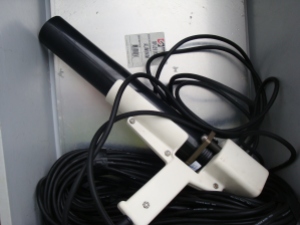

The probe is connected to a length of copper wire, which runs continuously as the probe sinks through the water column. It is important to launch the probe as far away from the ship as possible, as the copper wire should never touch the ship. If the wire were to touch the ship, the data feed back to the ship would be disrupted and we would have to launch another probe, which is a waste of money and equipment. The survey technician decides to cut the wire when he/she has determined that sufficient data has been acquired. This normally occurs when the probe hits the ocean floor.
This is a quick and convenient way to collect data on the depth and temperature of the water column. While the ship has other methods of collecting this data (such as a Conductivity, Temperature, and Depth (CTD) probe), the XBT is a simpler system that does not need to be recovered (as opposed to the CTD).

Species Seen
Humpback Whales
Northern Fulmar
Albatross
Northern Smoothtongue
Walleye Pollock
Mackerel
Lumpsucker
Squid
Pacific Sleeper Shark
Reader Question(s) of the Day!
Today’s reader questions come from James and David Segrest, who are two of my students in Knoxville Zoo’s homeschool Tuesday classes!
1. Did pirates ever travel the path you are on now? Are there any out there now?
A. As far as I know, there are no pirates currently operating in Alaska, and according to the scientists, there were not any on the specific route that we are now traveling. However, Alaska does have a history of piracy! In 1910, a man named James Robert Heckem invented a floating fish trap that was designed to catch salmon. The trap was able to divert migrating salmon away from their normal route and into a funnel, which dumped the fish off into a circular wire net. There, the fish would swim around until they were taken from the trap.

For people who liked eating fish, this was a great thing! The salmon could be caught quickly with less work, and it was fresh, as the salmon would still be alive when taken from the trap. For the traditional fisherman, however, this was terrible news. The fishermen could not compete with the traps and found that they could not make a living. The result was that the fishermen began raiding the floating traps, using any means possible.
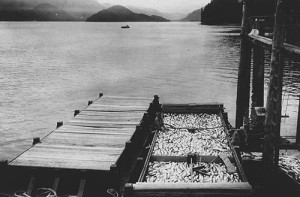
The most common method used was bribery. The canneries that operated the traps would hire individuals to watch the traps. Fishermen would bribe the watchers, steal the fish, and then leave the area. The practice became so common that the canneries began to hire people to watch the trap-watchers.
2. Have you seen any sharks? Are there any sharks that roam the waters where you are traveling?



This is a Pacific Sleeper Shark. It is called a sleeper shark as it does not appear to move a great deal, choosing instead to glide with very little movement of its fins. As a result, it does not make any noise underwater, making it the owl of the shark world. It hunts much faster fish (pollock, flounders, rockfish) by being stealthy. They are also known to eat crabs, octopus, and even snails! It is one of two animals known to eat giant squid, with the other one being sperm whales, although it is believed that these sharks probably scavenge the bodies of the much larger squid.
The other shark commonly seen is the salmon shark. Hopefully, we will catch one of these and I will have photos later in the trip.
NOAA TEACHER AT SEA
JASON MOELLER
ONBOARD NOAA SHIP OSCAR DYSON
JUNE 11 – JUNE 30, 2011
NOAA Teacher at Sea: Jason Moeller
Ship: Oscar Dyson
Mission: Walleye Pollock Survey
Geographic Location: Gulf of Alaska
Dates: June 14-16, 2011
Personal Log
Welcome back, explorers!
June 14
I think I posted my last log too soon, because as soon as I hit the send button interesting things began to happen. First, I was called up to see some Mountain Goats feeding in the wild! I was able to take a picture of them as well! (Well, kind of…)

While this was going on, the professional members of the science team were still calibrating the sonar that we are going to use to catch the fish! I have explained the process in the captions of the following photographs.

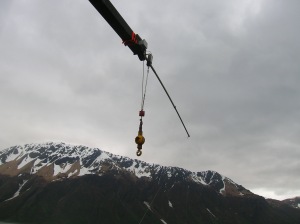

The process took several hours, but once we finished, we headed back out to sea to start the two-day journey towards our first fishing spot!
June 15-16
The most common sight off of the boat for the past two days has been this one.

We are currently in Unimak Pass, which will lead us to the Bering Sea! Unimak Pass is the fastest sea route from the United States into Asia, and as a result is a common merchant route between Seattle and Japan. It is also the best way to avoid rough seas and bad weather when travelling between the Gulf of Alaska and the Bering Sea, as it receives some cover from the landmass.
The Bering Sea likely needs no introduction, as it is arguably the best crab fishing waters on the planet and is well-known from the television show The Deadliest Catch. Aside from crab, the Bering Sea is teeming with life such as pollock, flounder, salmon, and halibut. As a result of this diverse and tasty biomass, the Bering Sea is an incredibly important area to the world’s fisheries.
Steaming towards our destination has kept us away from any land, but there are still things to do and to see! We did a second dry cast of the net, but this time two different pieces of equipment were tested.



Even though this was a test run and we did not catch any fish, the birds saw the net moving and came to investigate. The remaining photographs for the personal log are of the several species of birds that flew by the boat.
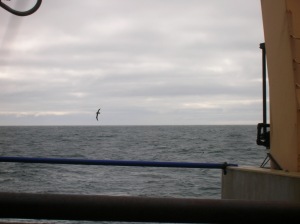

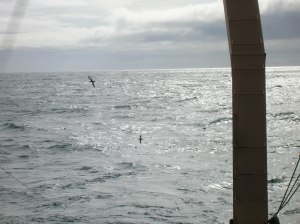
Science and Technology Log
This section of the blog will be written after we start fishing for Pollock in the next day or so!
New Species
Mountain Goats
Northern Fulmar
Albatross
Gulls
Reader Question(s) of the Day!
First, I owe a belated shout out to Dr. John, Knoxville Zoo’s IT technician. He lent me the computer that I am currently using to post these logs, and I forgot to mention him in the last post. Thanks Dr. John!
The two questions of the day also come from Kaci, a future Teacher at Sea with NOAA.
1. What is it like sleeping on the boat?
A. Honestly, I am being jostled around quite a bit. Part of this is due to the way the beds are set up. The beds go from port to starboard (or right to left for the landlubbers out there) instead of fore to aft (front to back). This means that when the boat rolls, my feet will often be higher than my head, which causes all of blood to rush to my head. I still haven’t gotten used to the feeling yet.
Part of the jostling, though, is my fault. I had heard that most individuals took the bottom bunks given the option, and since I was one of the first individuals on board, I decided to be polite and give my roommate, who outranked me by some 10-15 years at sea, the bottom bunk. It turns out that the reason people pick the bottom bunk is that the top bunk moves around more since it is higher off the floor. I’ve heard stories about people being thrown from the top bunk in heavy seas as well.
The most comfortable place to sleep has turned out to be the beanbag chair in the common room. It is considered rude to go into your room if your shift ends early, as your roommate may still be sleeping. My shift ended two hours early the other night, so I sat down on the beanbag chair to catch some zs. The ship’s rocking was greatly reduced by the bean bag chair, and I slept very well for the next couple of hours.
2. Is it stressful so far?
A. The only stressful part of the trip so far has been the seasickness, which I have not yet been able to shake. The rest of it has been a lot of fun!
NOAA TEACHER AT SEA
JASON MOELLER
ONBOARD NOAA SHIP OSCAR DYSON
JUNE 11 – JUNE 30, 2011
NOAA Teacher at Sea: Jason Moeller
Ship: Oscar Dyson
Mission: Walleye Pollock Survey
Geographic Location: Gulf of Alaska
Dates: June 13-14, 2011
Personal Log
Welcome back explorers!
June 13th

We are finally underway! The weather cleared up on the 12th, so the rest of our scientific party was finally able to make it in from Anchorage. The scientists did not arrive until later in the day, but at 9:00 in the morning, the Oscar Dyson finally left port in order to run some tests, including a practice cast of the fishing net!
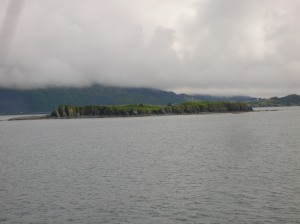
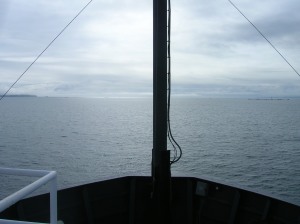
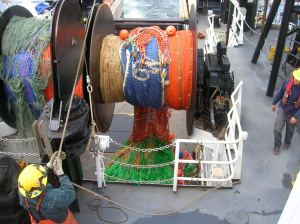
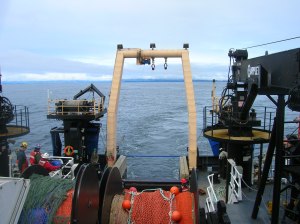

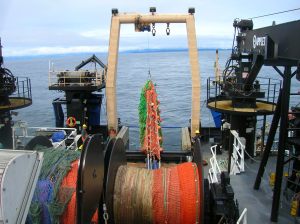
Once the tests were completed, we headed back towards the harbor to pick up the rest of the scientists. Once we were all on the vessel, we held a quick briefing on the ship rules. This was followed by a meeting among the scientists where shifts were handed out. I am on the 4 PM to 4 AM shift, also known as the night shift! Hopefully, I will see some northern lights during the few hours that we actually have darkness. After the meeting and a fast guided tour, I went to bed, as I was extremely seasick. Hopefully, that is a temporary issue.
June 14
I woke up to discover that the ship has anchored in a protected cove for the day in order to calibrate the acoustic devices on board that are used for fishing. This is a time consuming but necessary process as we will need the baseline data that the scientists receive by calibrating the device. However, that means that there is not much to do except for eating, sleeping, watching movies (we have over 1,000 aboard) and enjoying the beautiful scenery. As we are in a quiet cove with no waves, I am not currently sick and decided to enjoy the scenery.
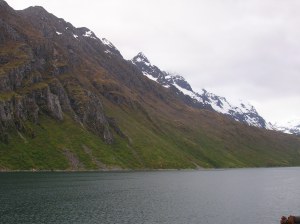
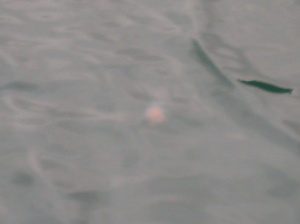

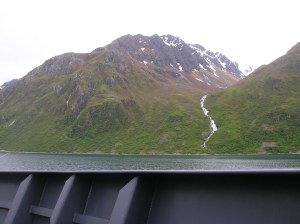
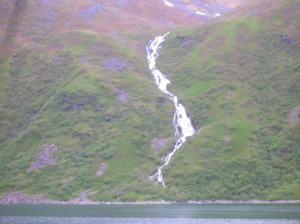
Science and Technology
The Science and technology segment of the blog will be written at the start of the Walleye Pollock survey, which should begin in the next day or so.
Species Seen
Jellyfish!
Arctic Tern
Gulls
Reader Question(s) of the Day
I received a few questions from Kaci, who will be a TAS here in September!
1. What is the temperature here?
A. The temperature has been in the mid to upper 40s, so much cooler then back home in Knoxville, Tennessee, where we were getting 90 degree days! It’s actually been pleasant, and I have not been cold so far on this trip.
2. What did you bring?
A. The temperature affected what I brought in terms of clothing. I started with a weeks worth of shorts and t-shirts, which I stuffed in my check in bag, and then two days worth of clothes in my backpack just in case my checked bag didn’t get it. Our other TAS, Tammy, got stuck here with only the clothes on her back, so a backup set of clothes was necessary. In addition, I have several pairs of jeans, 2-3 sweatshirts, a heavy coat, and under armor to round out the clothing. The under armor and heavy coat have been great, it’s why I haven’t been cold. I also packed all of my toiletries (though I forgot shampoo and had to buy it here.
In terms of electronics, I have my iPod, computer, and my wife’s camera with me. (A special shout out to Olivia is in order here, thanks for letting me use the camera! I am being VERY careful with it!). I have a lot of batteries for the camera, which I have needed since I’ve already gone through a pair!
Just for fun, I brought my hockey goalie glove and ball to use in working out. We have weight rooms aboard the ship, which I will definitely need since the food is fantastic!
I hope that answers those questions, and I will answer more in the next post!